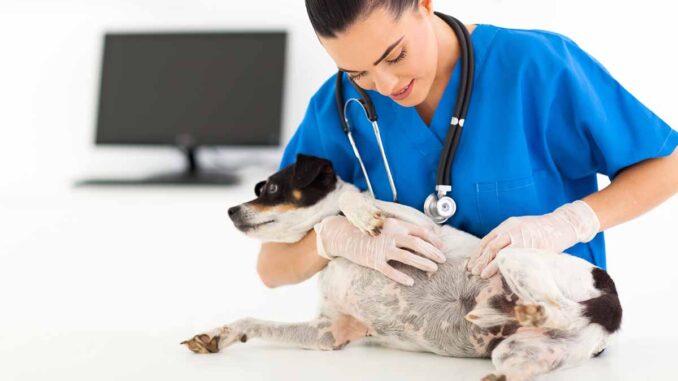
This article was updated on December 23rd, 2022
The growth of a lump or a change in the appearance of your dog’s skin is concerning for any owner. Many owners that come to our office will jump to the worst conclusion and the word ‘cancer’ will come into their head.
However, not all skin growths are cancerous – in fact many are nothing to worry about. This article will help owners make an informed decision about what they should do it they find a growth on their dog’s skin, what types of growth exist and what options are available if their dog is diagnosed with skin cancer.
Can Dogs Get Skin Cancer?
Just because our furry companions are covered in hair that doesn’t mean they are immune to skin cancer. While thick fur can provide some protection from UV radiation produced by the sun, dogs can still develop lumps within or under their skin. In fact, skin tumors are the most common form of cancer in dogs.
Finding a Suspicious Lump on Your Dog?
A good habit for any dog owner is to regularly be running your hands through their coat to check for any lumps. Set some time aside once a week to examine your dog – feel for any lumps and bumps and make note of anything unusual you find. Be sure to record the appearance and rough size of the lump and you can even take a photograph.
If you’ve found a suspicious lump on your dog then you have two options: Monitor it for the next few weeks, paying close attention to any changes, or visit your local veterinarian who can examine it and carry out testing.
What Skin Cancer Looks Like on a Dog
The first distinction that needs to be made is if a lump is malignant (cancerous) or benign. While testing would be required to investigate which category a lump falls under, and you can never say for sure by just looking at a lump, there are some clues that might point towards one or the other.
- Rate of growth: The speed at which a lump grows can be an indication of malignancy. Cancerous lumps tend to grow a lot faster than those that are benign and are very locally invasive – meaning that they will grow into and invade surrounding healthy tissue. While there is no hard and fast rule for the rate of growth, if a lump is doubling in size over the course of a few weeks then it presents more of a concern.
- Texture: While not always true, cancerous lumps tend to be both firmer and harder in texture.
- Shape: Cancerous lumps are often more irregular in shape then benign lumps, which tend to be smoother and more rounded.
- Color: Skin cancer usually appears to look more ‘angry’ in color; bright red, blue or black lumps may indicate a more sinister type of lump.
- Discharge: Any signs of discharge or bleeding may indicate a lump of cancerous origin. While any lump can develop secondary infection, sinister lumps are more prone to producing pus and bleeding.
Skin Cancer: A Common and Treatable Disease in Dogs
Which skin cancers are the most common in dogs?
Skin cancer is the most common type of tumor in dogs, representing about one-third of all tumors reported to affect dogs. Up to twenty percent of these skin tumors are mast cell tumors. About half of skin tumors will appear on the body, forty percent on the limbs and the remainder on the head and neck.
The most common types of malignant skin cancers found in dogs are as follows:
1. Mast Cell Tumors (est. 10-20% of skin tumors)
Mast cell tumors are the most common form of skin cancer in dogs. They are formed from the multiplication of a type of cell known as a mast cell. Mast cells are essential for the immune system to function and they produce histamine, a chemical that is released when an allergen is detected. Histamine results in the symptoms of an allergic reaction such as red skin and itching.
A mast cell tumor occurs when these mast cells uncontrollably multiply in a specific area of the skin. These tumors most commonly appear on the trunk of a dog’s body, but in about 25% of cases they will grow in the limbs. Mast cell tumors most commonly affect old dogs and breeds such as Boxers, Pugs, Rhodesian Ridgebacks and Boston Terriers seem to be predisposed.
Mast cell tumors vary in their appearance; they are often a raised lump and can appear red, ulcerated and inflamed.
Mast cell tumors are slow to spread and surgical removal with good margins is usually curative with only 8% of these tumors returning down the line.
2. Malignant Melanoma (est. 5% of skin tumors)
Malignant melanoma is a tumor of pigment-producing cells known as melanocytes. These cells give your dog’s skin its color and as a result as tumor of these cells is often darker in color.
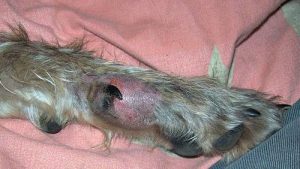
Melanomas most often occur on the lips and mouth, but the head, neck and scrotum are also slightly more prone to this type of cancer. Males tend to be more affected than females and certain breeds are predisposed including Schnauzers and Scottish Terriers.
Malignant melanomas usually appear as raised lumps, often dark in color and can be ulcerated on the surface.
Malignant melanomas are an aggressive type of tumor and do have the tendency to spread, or metastasize, to other areas of the body. The first sites of metastasis are often the local lymph nodes and the lungs. About 80-85% of dogs with oral malignant melanoma will show some degree of spread of the tumor, even after complete surgical removal of the primary tumor.
3. Squamous Cell Carcinoma
A squamous cell carcinoma (SCC) is a result of the abnormal growth of a type of cell known as a squamous cell, which usually resides in the outer most layer of the skin. This type of tumor can occur anywhere that these cells are found but most commonly affects the abdomen, back, ears, nose, and paw pads. Exposure to UV radiation from the sun contributes to the formation of these tumors.
SCC most commonly affects older dogs and breeds such as Basset Hounds, Boxers, Standard Poodles and Bloodhounds. These tumors are variable in appearance but may look like areas of ulcerated, inflamed or crusty skin.
While SCC most commonly occurs as a single lesion, a type of SCC known as multicentric squamous cell carcinoma can occur – this results in multiple lesions in different parts of a dog’s body. This form of SCC is very rare, however.
The prognosis for a dog with squamous cell carcinoma depends largely on the area of the body it affects and if metastasis has occurred.
Also see our page about dog skin lesions due to cancer.
Can Dog Warts be Cancerous?
You may have noticed what look to be warts growing on your dog. These are technically named papillomas and are caused by an infection with a virus known as papillomavirus. This virus usually infects the skin where there is weakness, such as an area of dry skin or a small break in the skin.
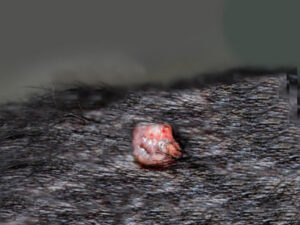
Warts for the most part are benign and won’t cause any harm to your dog. However, they can be easily mistaken for more sinister tumors such as the ones listed above so it’s still important to get them checked out by your vet.
How is Skin Cancer Diagnosed and Treated in Dogs?
Diagnosis of skin cancer is done through examining samples of the lump under a microscope. These samples can be taken by two methods: Fine Needle Aspirate (FNA) or Biopsy.
An FNA involves putting a small needle into the mass and suctioning out a sample of cells with a syringe. Any cells collected can be smeared onto a microscope slide and examined. While the results obtained from an FNA can be variable, the advantage is that this procedure can usually be performed on a conscious dog without the need for sedation or anesthetic.
A biopsy involved surgically removing a small wedge of the tumor in order for the cells and structure of the mass to be examined under a microscope. This process, also known as histopathology, is a gold standard in achieving a conclusive result. However, the downside is that the biopsy must be taken under a general anesthetic, with which there are risks involved.
How is Skin Cancer Treated in Dogs?
Treatment of skin cancer will very much depend on the type of cancer present, location and if any spread of the tumor elsewhere has occurred.
The first goal with treatment is to remove the primary skin tumor. This is usually done surgically, and your vet will attempt to take wide ‘margins’ around the tumor. This means removing a ring of healthy-looking skin around the mass to ensure that any microscopic cancerous cells that may have spread are also removed, thus reducing the likelihood of recurrence. If the tumor is completely removed, then the skin cancer is often considered to be cured at this stage.
If metastasis is suspected, or if the mass cannot be completely removed, then chemotherapy and/or radiotherapy may also be performed.
FAQ
What Steps can be Taken to Prevent Canine Skin Cancer?
While in most cases the incidence of skin cancer is due to genetics, there are some steps an owner can take to reduce the liklihood of their dog developing certain types of skin cancer.
Sun exposure plays a part in the devlopment of certain types of skin cancer so limiting the time your dog spends in the sun and applying pet-friendly sunscreen to the most exposed areas of skin can help.
Regular at-home and veterainry checks are essential for keeping on top of your dog’s health. Give your dog a once over evey week, feeling for any raised areas of skin or changes. As the first signs of a skin lump looking sinister take your dog to your local vet. They may advise testing. The sooner treatment is started, the better the prognosis.
How Long Can dogs live with Skin Cancer?
This question is a little bit like asking how long a piece of string is, because there are so many factors that go into the overall prognosis of a dog with skin cancer.
Factors such as type of cancer, location on the body, size of tumor, metastasis and how soon treatment is started all play a role in determining the prognosis of a dog with skin cancer.
Mast cell tumors have the best prognosis with a good survival rate following complete surgical excision. However, in the case of aggressive mast cell tumors that have metastasized elsewhere in the body, life expectancy is reduced to 4-6 months.
Dogs with malignant melanomas have a varied survival time depending on what stage the cancer is at. These types of tumors are staged based on their size and whether the local lymph nodes are affected. With surgery alone the median survival times range from 3-18months, with the shorter survival times corresponding to dogs with later stages of cancer. Dogs with stage IV disease (involving metastasis elsewhere in the body) only have a survival time of 1 month as surgery alone is not an option in these cases. Additional therapies such as radiotherapy and chemotherapy aim to increase these survival times.
Squamous cell carcinoma also has a varied survival time based on the location of the tumor. The overall median survival time for dogs with these tumors is just less than 3 years
What is the Best Way to Care for my Dog who has Skin Cancer?
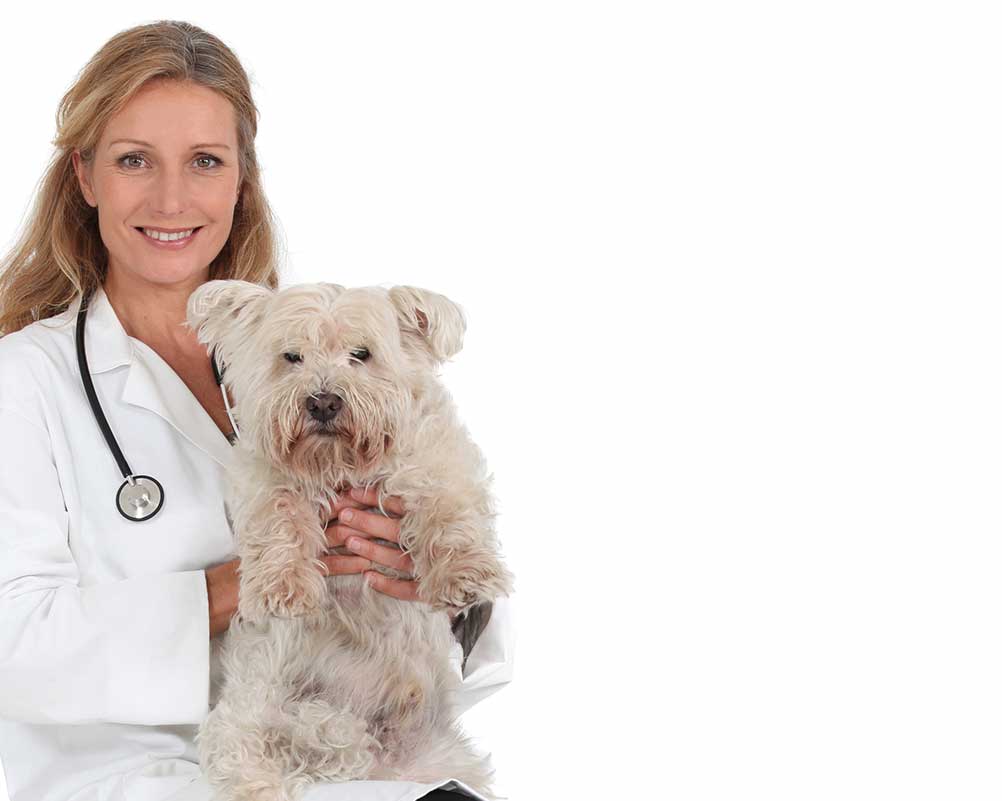
Caring for a dog with skin cancer will require very close monitoring on the part of the owner. If previous tumors have been surgically removed, then regular checks to make sure that the cancer isn’t coming back are essential.
If a tumor cannot be successfully removed and your dog is on palliative care, then keeping them comfortable is the most important thing. Feed them an enjoyable diet and be sure to keep the tumor clean so that it doesn’t develop secondary infections.
It’s also important to avoid over-exposing your dog to direct sunlight, especially if they have been previously diagnosed with squamous cell carcinoma.
Read More About Dog’s Lumps and Bumps:
 11 Types of HARD Lumps on Dogs [With Pictures] - Hard lumps can be a wide range of things, some of which are worrying and sinister and others that are… [...]
11 Types of HARD Lumps on Dogs [With Pictures] - Hard lumps can be a wide range of things, some of which are worrying and sinister and others that are… [...]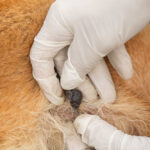 6 Types of Black Lumps on Dogs [With Pictures] - It can be concerning to see a new black lump on your dog, particularly because black growths may mean cancer… [...]
6 Types of Black Lumps on Dogs [With Pictures] - It can be concerning to see a new black lump on your dog, particularly because black growths may mean cancer… [...] White Bumps on Dogs: 7 Vet-Explained Causes with Pictures - White lumps and bumps might seem unusual. However, as a veterinarian, I have seen them more often than you might… [...]
White Bumps on Dogs: 7 Vet-Explained Causes with Pictures - White lumps and bumps might seem unusual. However, as a veterinarian, I have seen them more often than you might… [...] 5 Causes of Bumps on a Dog’s Chin [Pics & Vet Advice] - It’s always concerning to see bumps developing on your dog’s chin: they’re unsightly and often cause your dog irritation and… [...]
5 Causes of Bumps on a Dog’s Chin [Pics & Vet Advice] - It’s always concerning to see bumps developing on your dog’s chin: they’re unsightly and often cause your dog irritation and… [...]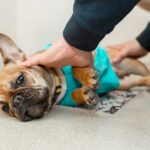 Chest or Rib Cage Lumps In Dogs [Vet Advice] - Lumps and bumps on dogs' chests and rib cages are a common finding in our vet clinic, especially in older… [...]
Chest or Rib Cage Lumps In Dogs [Vet Advice] - Lumps and bumps on dogs' chests and rib cages are a common finding in our vet clinic, especially in older… [...] Mast Cell Tumors vs Histiocytomas in Dogs [10 pictures] - According to research, histiocytomas make up 15.9% of tumors found in dogs, while mast cell tumors make up 17.8%. In… [...]
Mast Cell Tumors vs Histiocytomas in Dogs [10 pictures] - According to research, histiocytomas make up 15.9% of tumors found in dogs, while mast cell tumors make up 17.8%. In… [...]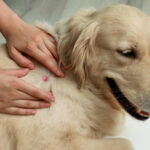 Red Alert: 9 Types of Red Lumps on Dogs [With Pictures] - Seeing a new red lump or bump on your dog can be scary. But don't jump to conclusions just yet.… [...]
Red Alert: 9 Types of Red Lumps on Dogs [With Pictures] - Seeing a new red lump or bump on your dog can be scary. But don't jump to conclusions just yet.… [...]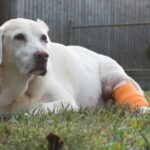 Mast Cell Tumors In Dogs: A Veterinarian’s Guide for Owners - Mast cell tumors are one of the most common forms of cancer in dogs. They account for almost 20-25% of… [...]
Mast Cell Tumors In Dogs: A Veterinarian’s Guide for Owners - Mast cell tumors are one of the most common forms of cancer in dogs. They account for almost 20-25% of… [...] Is It a Dog Wart or a Skin Tag? How to Tell the Difference [6 Pictures to Compare] - Warts and skin tags are common occurrences on our pup’s skin. At first glance, they may appear the same, but… [...]
Is It a Dog Wart or a Skin Tag? How to Tell the Difference [6 Pictures to Compare] - Warts and skin tags are common occurrences on our pup’s skin. At first glance, they may appear the same, but… [...]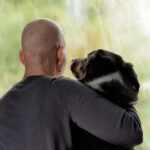 Pictures of Dog Skin Lesions or Lumps Due to Cancer - As a veterinarian, I often come across dog parents who are concerned about their pet's skin lesions or lumps and… [...]
Pictures of Dog Skin Lesions or Lumps Due to Cancer - As a veterinarian, I often come across dog parents who are concerned about their pet's skin lesions or lumps and… [...]Disclaimer: This website's content is not a substitute for veterinary care. Always consult with your veterinarian for healthcare decisions. Read More.


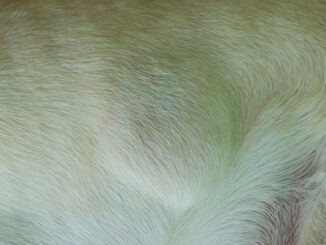
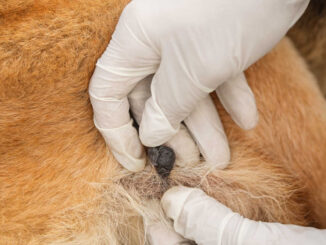
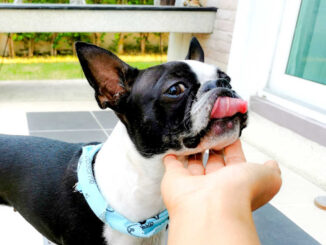
Be the first to comment